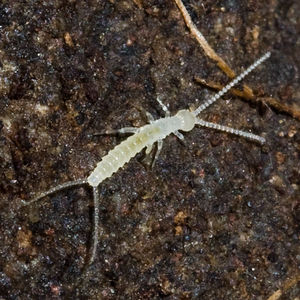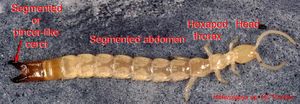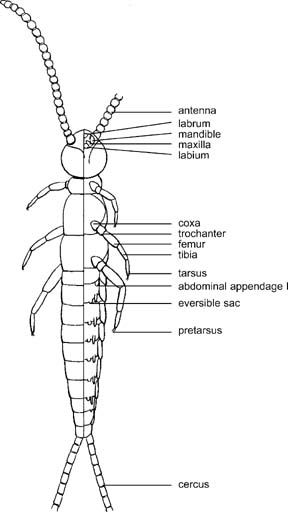Diplura

Diplura whos name comes from diploos - double, oura – tail, referring to the two prominent cerci that Diplura have [1]. They are small, elongated, delicate, primitive arthropods that are characterized by ten abdominal segments, absence of compound eyes, lateral styli and eversible vesicles ventrally on one or more of the first seven body segments, and caudal cerci [5]. Most diplurans are euedaphic, but some are nocturnal cryptozoans, hiding under stones or tree bark during the day [2]. Diplurans are [3]. There are over 800 species of dipluran that make up 8 families, 6 of which are in North America, and 170 species of dipluran making up 23 genera have been collected in North America [5].
Superfamilies and Families (Based on Allen 2002))
Projapygoidea
Projapygoidea is a superfamily that contains two families (Anajapygidae and Projapygidae) both of which can be found in North America. It is said that this group represents the oldest phylogenetic linages that eventually led to the evolution of the class Insecta as a whole.
- Anajapygidae
- Most diverse in Central and South America but does have three species in North America and one in Italy. Characteristics of the Anajapygidae family are: cephalic suture reduced to its posterior :branch; trichobothria on antennal segments 5-10 and in some species on even numbered segments distal to segment 10; labial palpi rudimentary; appendages of the subcoxal organs on abdominal sternite I :pyriform; and a pair of exertile organs on abdominal sternites 2-7.
- Projapygidae
- Found around the world in places such as North and South America, Europe, Africa, China, India, and Austrailia. Characteristics of the Projapygidae family are: a complete cephalic suture; :trichobothria present on antennal segments 4-22; labial palpi well developed; subcoxal appendages on abdominal sternite 1 that is cylindrical; and abdominal sternites without exertile vesicles.
Campodeoidea
Campodeoidea is a superfamily that includes Procampodeida, Campodeidae, and Octostigmatidae [5].
- Procampodeidae
- Only one genus and two species have been described in this family. One species occurs in Italy and the other in California [5]. Identifying characteristics include: Abdominal segments without :spiracles; trichobothria present on antennal segments III – VII; coxal vesicles on abdominal sternite I not developed; and styles absent [5].
- Campodeidae
- This is one of the two largest families in the Diplura. The group has worldwide distribution occurring on all continents except for Antarctica [5]. Identifying characteristics are: mandible with a :lacinia mobilies; trichobothria on antennal segments 3 III to VI; three pairs of spiracles on the thorax; long segmented cerci; epicranial suture that is usually complete; and abdominal sternite 1 with a :pair of distinct subcoxal appendages [5].
- Octostigmatidae
- This family is found in Asia however, it is not found in North America Identifying features include: a thorax with 2 pairs of spiracles; trichobothria present on antennal segments IV-XXII or V-XII only :[5]. A thorax with 4 pairs of spiracles; trichobothria present on antennal segments V-XVIII [5].
Japygoidea
Is a super family that includes Parajapygidae, Dinjjapygidae, and Japygidae.
- Parajapygidae
- Found in North America it is represented by two genera: Parajapyx and Miojapyx [5]. Characteristics useful in identifying members of this family include: antennae without trichobothria and with a maximum :of 4 placoid sensillae on the terminal article; thorax with 2 pair of spiracles; and an abdominal sternite I with a pair of styles and a pair of lateral subcoxal organs [5].
- Dinjapygidae
- This family is only known to be found in South America, Peru, and Bolivia [5]. Identifying characteristics include: trichobothria present on antennal segments 4-17 or 4-20 [5].

- Japygidae
- Japygidae are the largest of group of Diplurans with about 70 genera [3]. Identifying characteristics include: labial palps presents; 4 pairs on thoracic spiracles; trichobothria present on antennal :segments 4-6 [5].
Anatomy

Dipluran have two appendages or cerci extending backwards from the last of their abdominal segments [3]. There are three major types of cerci: Type 1 are Elongated, segmented, filamentous cerci which have a variable number of segments. These cerci are covered with a variable number of long and short setae that may be smooth or barbed. The setae often occur in distinct whorls and anal gland ducts are absent. See Figure 1[5]. Type 2 are Elongated, many-segmented, and covered with setae but each has an internal canal connected to the anal glands, in type 2 the apex of the terminal segment is distinctly modified, cerci. See Figure 1. [5]. Type 3 are Unsegmented, robust, and usually heavily sclerotized forceps [5]. They are blind, pale, and normally small in size ranging from 205 mm however in topical environments some species can be larger [3].
Diet
Some Diplura are herbivorous feeding on plant roots and fungi that are decomposing plant matter [4]. Others are predaceous who primarily hunt other small arthropods [1]. The predatory species wait buried in the soil with the tip of there abdomen on the surface waiting for arthropods to encounter their pincer-like cerci [4]
Reproduction
Sperm transfer is indirect similar to that of Collembola, the male deposits a spermatophore on the substrate [4]. The Female diplurans gather male spermatophores from on the ground, taking the spermatophores up thought the genital opening [3]. Eggs are laid in clusters in decomposing plant material or in crevices in the soil, in some species the females are known to guard the eggs and recently emerged larvae [4].
Ecology
Mainly found in moist environments, diplurans are often found in small groups or colonies in soil, leaf litter, moss, and under rocks [4]. Some species have been found in the nests of ants and termites and in caves. In some places in the world some root-feeding species have been reported as pests of crops such as sugar cane, peanuts, and melons [4].
References
1. Tree of Life Web Project. 1995. Diplura. Version 01 January 1995 (temporary). http://tolweb.org/Diplura/8204/1995.01.01 in The Tree of Life Web Project, http://tolweb.org/ 2. David Coleman, M. C., D. Crossley, Jr. 2017. Fundamentals of Soil Ecology. Third edition. Candice Janco, Academic Press.
3. Britannica, T. E. E. 2017. Dipluran. Encyclopaedia Britannica Inc.
4. Andrew Austin, E. F.-J., s Mark Harvey, Mike Hodda, John Jennings ,Claire Stephens, Erich Volschenk, David Yates. Key to Australian Freshwater and Terrestrial Invertebrates. https://keys.lucidcentral.org/keys/v3/TFI/start%20key/key/hexapoda%20key/Media/HTML/Diplura.html
5. Allen, R. T. 2002. A Synopsis of the Diplura of North America: Keys to Higher Taxa, Systematics, Distributions and Descriptions of New Taxa (Arthropoda: Insecta). Transactions of the American Entomological Society (1890-) 128:403-466. http://www.jstor.org/stable/25078790